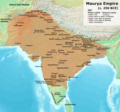File:Maurya Empire, c.250 BCE 2.png

Size of this preview: 642 × 600 pixels. Other resolutions: 257 × 240 pixels | 514 × 480 pixels | 822 × 768 pixels | 1,200 × 1,121 pixels.
Original file (1,200 × 1,121 pixels, file size: 2.26 MB, MIME type: image/png)
File history
Click on a date/time to view the file as it appeared at that time.
| Date/Time | Thumbnail | Dimensions | User | Comment | |
|---|---|---|---|---|---|
| current | 04:37, 16 April 2024 |  | 1,200 × 1,121 (2.26 MB) | Avantiputra7 | Reverted to version as of 11:12, 5 April 2024 (UTC) - vandalism |
| 07:37, 14 April 2024 |  | 1,200 × 1,121 (2.18 MB) | Layman7676 | Reverted to version as of 11:12, 4 April 2024 (UTC) The map you are publishing isn't based on wha vincient Arthur really said. | |
| 11:12, 5 April 2024 |  | 1,200 × 1,121 (2.26 MB) | Avantiputra7 | Reverted to version as of 08:27, 3 April 2024 (UTC) - vandalism | |
| 11:12, 4 April 2024 |  | 1,200 × 1,121 (2.18 MB) | Chakravartin1929 | Reverted to version as of 05:41, 26 March 2024 (UTC) This is the true map. It depicts The mauryan map accurately. | |
| 08:27, 3 April 2024 |  | 1,200 × 1,121 (2.26 MB) | Avantiputra7 | Reverted to version as of 11:06, 3 March 2024 (UTC) | |
| 05:41, 26 March 2024 |  | 1,200 × 1,121 (2.18 MB) | Chakravartin1929 | Reverted to version as of 09:06, 3 March 2024 (UTC) | |
| 11:06, 3 March 2024 |  | 1,200 × 1,121 (2.26 MB) | Avantiputra7 | Reverted to version as of 11:10, 29 January 2024 (UTC) | |
| 09:06, 3 March 2024 |  | 1,200 × 1,121 (2.18 MB) | Chakravartin1929 | Reverted to version as of 16:50, 14 December 2023 (UTC) This map is better. | |
| 11:10, 29 January 2024 |  | 1,200 × 1,121 (2.26 MB) | Avantiputra7 | tweaked | |
| 02:15, 29 January 2024 |  | 1,200 × 1,121 (2.26 MB) | Avantiputra7 | adjusted borders to match Joppen's, and as per discussions added labelling of provinces |
File usage
The following 2 pages use this file:
Global file usage
The following other wikis use this file:
- Usage on am.wikipedia.org
- Usage on ar.wikipedia.org
- Usage on azb.wikipedia.org
- Usage on ba.wikipedia.org
- Usage on be.wikipedia.org
- Usage on bg.wikipedia.org
- Usage on bn.wikipedia.org
- Usage on ckb.wikipedia.org
- Usage on de.wikipedia.org
- Usage on en.wikipedia.org
- Ashoka
- Talk:History of India
- Magadha
- Maurya Empire
- Arthashastra
- Kalinga (historical region)
- Economic history of India
- Tamilakam
- Pataliputra
- Indian people
- Mahameghavahana dynasty
- Three Crowned Kings
- List of rulers of Odisha
- Talk:India/Archive 39
- Talk:Maurya Empire/Archive 1
- Wikipedia:Dispute resolution noticeboard/Archive 135
- User:Falcaorib
- Talk:Maurya Empire/Archive 2
- List of Maurya Emperors
- Usage on en.wiktionary.org
- Usage on es.wikipedia.org
- Usage on he.wikipedia.org
- Usage on hi.wikipedia.org
- Usage on hy.wikipedia.org
- Usage on id.wikipedia.org
- Usage on it.wikipedia.org
- Usage on ja.wikipedia.org
- Usage on kn.wikipedia.org
- Usage on ko.wikipedia.org
- Usage on lv.wikipedia.org
- Usage on ml.wikipedia.org
- Usage on mzn.wikipedia.org
View more global usage of this file.
